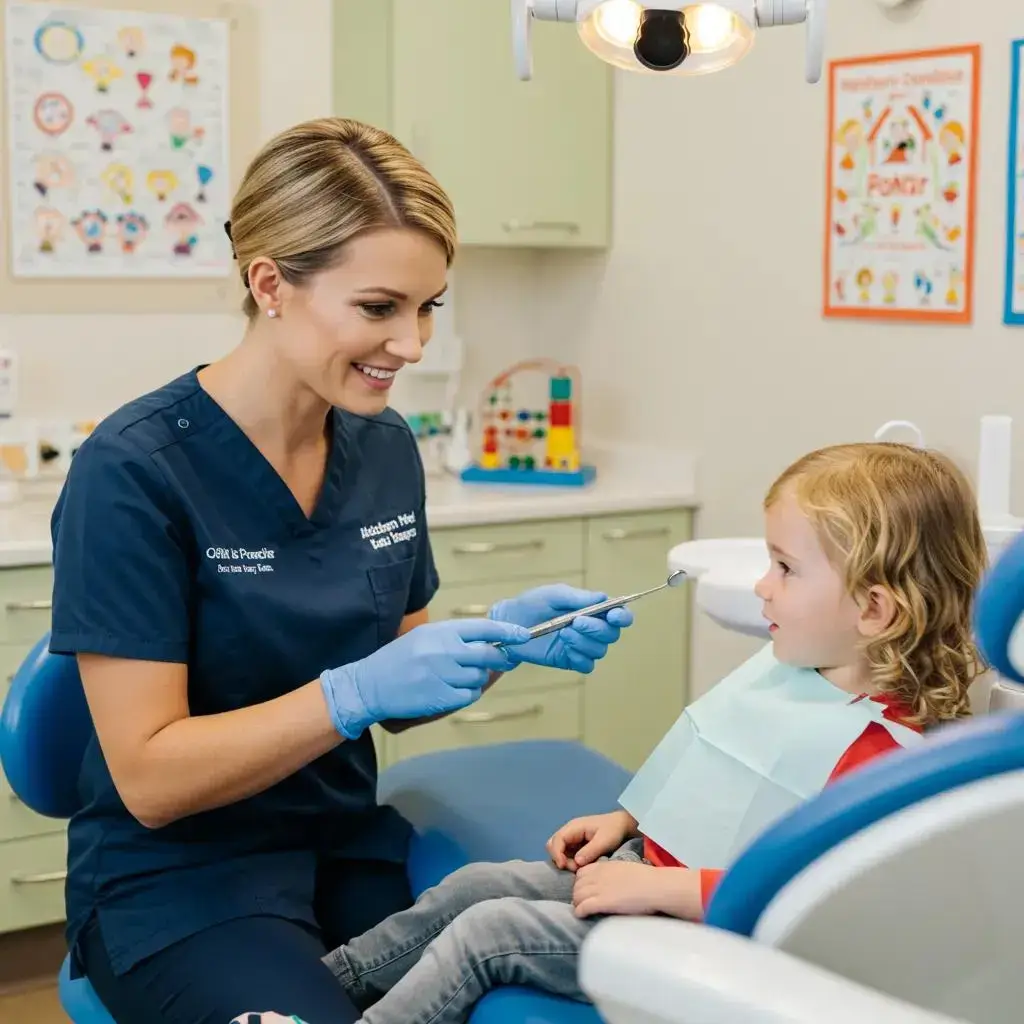Choose the Best Family Dentistry in Kendall, Florida – Guide

How to Choose the Right Family Dentistry: The Complete Guide to Finding the Best Family Dentist for Your Needs by Dr. Omar Villavicencio of People First Dentistry
Family dentistry offers comprehensive oral healthcare for all ages, from infants to seniors, focusing on prevention, diagnosis, and treatment of common dental conditions. This guide explains how to vet a family dentist, what services to expect, and which practical and financial factors influence your choice, helping you make informed comparisons. Many families face challenges with scheduling, insurance, and managing dental anxiety, which a suitable family dentist can resolve by combining preventive strategies with age-appropriate care. You will learn what family dentistry covers, key qualifications, how to evaluate patient experience and technology, and how to compare costs and specialized services. The article also provides checklists and decision guidance to help you select a practice that fits your household’s needs.
What Is Family Dentistry and Why Is It Important for Your Family’s Oral Health?
Family dentistry integrates preventive, restorative, pediatric, cosmetic, and emergency dental services under one provider, simplifying oral healthcare for families. This model ensures continuous records, enabling early detection of developmental issues in children and consistent management of chronic conditions in adults, which can reduce long-term oral health costs. The primary benefit is continuity of care: the same clinical team understands family history, risk factors, and treatment preferences, improving outcomes and patient comfort. Understanding this scope helps families prioritize practices emphasizing preventive care and pediatric-friendly approaches.
What Services Does Family Dentistry Typically Offer?

Family dentistry typically includes preventive, restorative, cosmetic, pediatric, and emergency services tailored to age. Preventive services cover check-ups, cleanings, sealants, and fluoride treatments. Restorative care includes fillings, crowns, bridges, and extractions. Cosmetic services like whitening or veneers address aesthetic concerns. Emergency care for all ages often involves same-day assessment for trauma or severe pain, making prompt access a core expectation.
How Does Family Dentistry Benefit Patients of All Ages?
Family dentistry benefits children through early checkups, developmental monitoring, and preventive measures like sealants. Adults benefit from coordinated restorative and cosmetic care, while seniors receive attention for medication interactions, root caries prevention, and prosthetic maintenance. This lifecycle care approach ensures routine visits detect issues early, leading to less invasive and more cost-effective interventions. Families also gain scheduling convenience and consistent communication, reducing missed appointments and confusion.
What Is the Difference Between a Family Dentist and a General Dentist?
A family dentist is trained and organized to treat patients of all ages within one practice, often emphasizing pediatric behavior management, age-specific preventive protocols, and continuity of records. A general dentist may focus primarily on adult care or a narrower patient base. This distinction matters because family dentists integrate pediatric milestones, adolescent orthodontic screening, and geriatric needs into longitudinal care pathways, reducing referrals and streamlining care for families.
What Key Qualifications and Experience Should You Look for in a Family Dentist?
A qualified family dentist holds a state dental license (DDS or DMD), maintains continuing education, and ideally demonstrates experience across pediatric, adult, and geriatric populations to ensure safe, age-appropriate care. Licensure confirms basic competency, while additional pediatric experience or coursework indicates readiness to manage child behavior and developmental needs. Continuing education and board certifications signal commitment to advanced standards and up-to-date techniques. Prioritizing these credentials assures reduced risk and expanded treatment options. Below is a concise comparison of common credentials:
Which Education, Licenses, and Certifications Are Essential for a Family Dentist?
Essential credentials include a current state license (DDS or DMD) and documented continuing education (CE) in areas relevant to family dentistry, such as pediatric behavior management, geriatric care, or sedation techniques. These requirements ensure baseline training and maintain competence as dental science evolves, keeping treatments effective and safe. Families should inquire about specific CE topics and any additional certifications related to children or special-needs care.
How Does Experience with Different Age Groups Impact Your Choice?
Experience treating infants, children, adults, and seniors indicates a dentist can adapt communication, preventive protocols, and treatment plans to various developmental stages and medical complexities. For example, pediatric appointments focus on behavior guidance, while senior care addresses medication interactions. A practitioner with cross-age experience connects these needs into cohesive care plans. Red flags include a practice lacking pediatric scheduling options or avoiding accommodations for special-needs patients.
What Specializations Should a Family Dentist Have?
Useful specializations for a family dentistry practice include pediatric dentistry, orthodontic partnership or in-house screening. These specializations expand in-house services or streamline referrals, enhancing continuity and reducing travel for families. Knowing whether a practice performs or refers specialty care affects convenience and speed of treatment, especially for time-sensitive needs.
Why Are Board Certifications and Continuing Education Important?
Board certifications and continuing education demonstrate a dentist actively updates skills and meets peer-reviewed competency standards, providing access to newer technologies and evidence-based treatments. CE ensures clinicians learn advances like digital impressions, laser dentistry, and teledentistry workflows, improving diagnostics and comfort. Families benefit from less invasive, faster procedures and better communication, reducing long-term costs and improving outcomes.
How Can You Evaluate the Patient Experience at a Family Dental Practice?
Patient experience encompasses the office environment, staff interactions, communication clarity, and technologies used. Evaluating these elements predicts comfort, adherence, and clinical results for the whole family. A welcoming, child-friendly waiting area and staff trained in pediatric communication reduce dental anxiety. Clear treatment explanations and transparent scheduling build trust for adults. Modern diagnostic tools like digital X-rays and intraoral scanning improve efficiency and lower exposure. Assessing these factors helps families find practices combining human-centered care with technological advantages.
What Makes a Dental Office Child-Friendly and Comfortable?
Child-friendly offices use design elements, scheduling practices, and behavior techniques to reduce fear and promote positive associations with dental visits. Examples include tv’s, shorter wait times for children, and empathetic clinical staff. Staff who explain procedures in child-appropriate language and use gradual exposure techniques create predictable experiences, lowering pediatric dental anxiety. This results in higher cooperation, fewer emergency visits, and better preventive outcomes.
How Do Staff Friendliness and Professionalism Affect Your Visit?
Staff friendliness and professionalism set the tone for the entire appointment. Responsive front-desk staff streamline scheduling and insurance checks, while clinical teams explaining steps and risks clearly promote informed consent and calm patients. Poor communication or dismissive attitudes can signal systemic issues, increasing stress for families. Positive staff interactions also encourage adherence to preventive schedules, improving long-term oral health.
Why Is Clear Communication Important When Choosing a Family Dentist?
Clear communication ensures families understand diagnosis, treatment options, alternatives, and cost implications, enabling informed decisions without surprises, especially for parents planning care for children. Practices providing itemized estimates, visual treatment plans, and plain-language explanations reduce anxiety and improve adherence. You can test communication by asking for a simple treatment plan and expected timelines during the first call; a clear response indicates a patient-centered practice.
How Does Modern Technology Enhance Your Dental Experience?
Modern technologies—digital X-rays, intraoral scanners and intraoral cameras—enhance diagnostics, reduce chair time, and improve patient understanding through on-screen visuals and faster treatment workflows. For families, intraoral scanning replaces messy impressions, digital radiography lowers radiation exposure. These tools increase diagnostic accuracy and patient engagement, improving outcomes and satisfaction while streamlining family schedules.
What Financial Factors Should You Consider When Selecting a Family Dentistry Practice?
Evaluating financial factors includes checking accepted dental insurance plans, available financing or payment options, and the practice’s transparency about costs to avoid unexpected bills. Understanding insurance types (PPO, HMO, Medicaid) and verifying participation prevents denial surprises and clarifies out-of-pocket expectations. Practices offering itemized estimates, pre-authorization assistance, and clear communication about in-network and out-of-network billing reduce administrative burden. Below is a practical comparison to interpret common insurance and payment options:
Which Dental Insurance Plans Are Commonly Accepted?
Many family dental practices accept PPOs and some HMOs; some also accept Medicaid or CHIP, depending on regional participation. Acceptance varies widely and requires verification for each practice. Provide your plan name and member ID to the office and request confirmation of benefits and co-pay expectations; ask if the practice files claims and handles pre-authorizations. Understanding in-network versus out-of-network reimbursement clarifies potential out-of-pocket responsibilities and helps families budget. At People First Dentistry we accept most PPO and Medicare plans.
What Payment Options and Financing Plans Are Available?
Common payment options include upfront payment, in-office payment plans, and third-party financing for larger restorative or orthodontic cases, each with trade-offs in cost and convenience. Financing spreads payments but may incur interest; in-office plans sometimes require deposits but keep billing simple; upfront payment can unlock discounts. Ask about eligibility, timelines, and whether financing covers preventive care or only major procedures. Clear answers allow families to balance immediate needs with long-term affordability. At People First Dentistry we offer Care Credit and Cherry as alternative payment options.
How Can You Ensure Cost Transparency and Get Accurate Estimates?
To ensure cost transparency, request an itemized written estimate, ask for alternative treatment costs, and request pre-authorization from your insurer when applicable so coverage is verified before work begins. A practical question template includes: “Can you provide an itemized estimate, expected insurance contribution, and any alternate treatment options?” Having these items in writing reduces billing disputes and helps families compare affordable family dentistry choices. At People First Dentistry we provide all costs associated with treatment prior to its commencement.
What Specialized Dental Services Should a Family Dentistry Offer?
A comprehensive family dentistry practice like People First Dentistry in Kendall, FL offers pediatric dental care, emergency services, cosmetic and restorative options, and accommodations for patients with special needs, meeting most household oral healthcare requirements. These specialized services tailor clinical protocols, scheduling, and physical environments to different patient groups, reducing fragmentation of care and improving continuity. Evaluating which services are offered in-house versus referred helps families weigh convenience against access to advanced specialty procedures. The table below summarizes typical specialized services:
Why Is Pediatric Dental Care Important for Your Child’s Oral Health?
Pediatric dental care establishes preventive routines, detects developmental milestones, and applies interventions like fluoride and sealants that significantly lower lifetime decay risk. Regular visits allow clinicians to catch enamel defects, bite problems, and habits like thumb-sucking before they require extensive treatment. The typical recommendation is the first dental visit by the eruption of the first tooth or by the first birthday, anchoring a prevention-first strategy.
How Do Emergency Dental Services Support Your Family’s Needs?
Emergency dental services provide rapid assessment and stabilization for trauma, severe pain, or infection, typically including same-day triage, pain control, and referral for definitive treatment. Immediate care for dental trauma can preserve teeth and reduce long-term complications; having a known family dentist streamlines this process. Practices advertising emergency availability and clear after-hours protocols reduce anxiety and improve outcomes for urgent situations.
What Cosmetic and Restorative Options Are Available in Family Dentistry?
Family dentistry commonly provides restorative treatments—fillings, crowns, bridges—and cosmetic options such as whitening and tooth-colored restorations, restoring function and improving confidence across different age groups. The decision to pursue cosmetic work often balances aesthetics with timing; adolescents may delay certain procedures until growth stabilizes, while adults choose options aligning with functional needs. Understanding typical outcomes, maintenance, and age-appropriate options helps families plan.
How Do Family Dentists Accommodate Patients with Special Needs?
Family dentists accommodate special-needs patients through sensory-friendly scheduling, private treatment rooms, staff trained in communication and behavior techniques, and pre-visit planning. Practical examples include longer appointment times, pre-visit orientation, and coordinating with caregivers to establish effective communication strategies. These adaptations improve access and outcomes for neurodiverse patients or those with mobility limitations, reinforcing comprehensive family care.
How Do You Make an Informed Decision When Choosing a Family Dentist?
Making an informed decision combines credential checks, patient-experience evaluation, and practical logistics into a stepwise process. Start with a shortlist based on insurance acceptance and location, then evaluate qualifications and in-office environment, and finish with an initial consultation to test communication and transparency. This method allows families to apply the same checklist to multiple practices and compare objective criteria like technology, pediatric readiness, and financial transparency.
Use this checklist of essential questions during an initial consultation to vet a family dentist:
- Experience with children: How often do you treat pediatric patients and what behavior techniques do you use?
- Technology and sterilization: Do you use digital X-rays, intraoral scanning, and what are your sterilization protocols?
- Emergency protocols: What is your policy for same-day emergency visits and after-hours care?
- Payment and insurance: Which plans do you accept, and can you provide an itemized estimate and financing options?
What Questions Should You Ask During Your Initial Consultation?
During the initial consultation, ask focused questions about treatment philosophy, pediatric experience, emergency availability, payment options, and expected timelines. Request to see sample treatment plans or digital images demonstrating how diagnoses are explained; practices presenting visual plans tend to communicate more clearly. These inquiries reveal day-to-day practice operations and prepare you to interpret patient testimonials.
How Can Patient Reviews and Testimonials Guide Your Choice?
Patient reviews offer real-world perspectives on appointment flow, staff demeanor, wait times, and outcomes. Evaluate them for specificity—detailed reviews about pediatric care, emergency responsiveness, or billing clarity are more reliable than generic praise. Red flags include repeated complaints about billing surprises or poor communication; consistent positive mentions of same-day emergencies, child-friendly staff, and transparent pricing are strong signals of quality. Use reviews to corroborate observations from initial calls and visits. Dr. Villavicencio and People First Dentistry are rate 5 out of 5 on Google.
Why Is Building a Long-Term Relationship with Your Family Dentist Important?
A long-term relationship enables continuity of records, personalized preventive plans, and early detection of trends like enamel wear or gum disease progression, reducing invasive interventions and emergency visits. A dentist familiar with your family history can tailor hygiene schedules, anticipate orthodontic needs, and coordinate multidisciplinary care. This continuity improves outcomes and simplifies logistics, especially valuable for busy households.
After this decision guidance, consider scheduling an initial consultation with a local family dentist to test communication and logistics; bring essential documents and questions to maximize that visit.
Initial Consultation Checklist
To make the most of your visit, remember to:
- Bring insurance cards and a list of current medications.
- Bring prior dental records or x-rays if available.
- Ask for an itemized estimate and expected timeline for recommended care.
- Request information on emergency policies and pediatric accommodations.
What Are the Practical Considerations for Choosing a Convenient Family Dental Practice?
Practical considerations include location, office hours, amenities, and digital tools like online booking, patient portals, and teledentistry capabilities. Convenience reduces missed appointments and improves adherence to preventive schedules; evening or weekend hours and proximity to school or work make routine visits manageable. Look for practices offering online booking, same-day emergency slots, and secure patient portals to streamline communications and paperwork. Evaluating these logistics helps prioritize practices that fit your household rhythm.
How Does Location and Office Hours Affect Your Family’s Dental Care?
Location and flexible office hours influence whether busy families can attend routine preventive visits and respond to emergencies without significant disruption. Practices near schools or along common commute routes reduce travel time, and evening/weekend availability reduces missed appointments. Considering after-hours access or established referral protocols for urgent cases adds resilience during accidents or acute pain.
What Amenities and Facilities Should You Expect in a Family Dental Office?
Expect must-have amenities like accessible parking, clean and safe waiting areas, and accessible restrooms. Nice-to-have features include private treatment rooms, family restrooms, and waiting areas that reduce stress. Accessibility for mobility-impaired patients and sensory-friendly environments for neurodiverse children are practical features that improve inclusion and comfort. These amenities indicate a practice invested in patient experience and operational quality.
- Amenities checklist (must-have vs nice-to-have):
- Must-have: accessible parking, clean facilities, clear signage.
- Nice-to-have: online check-in, private treatment rooms.
- Accessibility features: ramps, adjustable chairs, sensory-friendly scheduling.
- Must-have: accessible parking, clean facilities, clear signage.
- Nice-to-have: online check-in, private treatment rooms.
- Accessibility features: ramps, adjustable chairs, sensory-friendly scheduling.
Ready to Find Your Family Dentist?
Book an appointment with Dr. Omar Villavicencio at People First Dentistry Tel. 786-310-3540.

